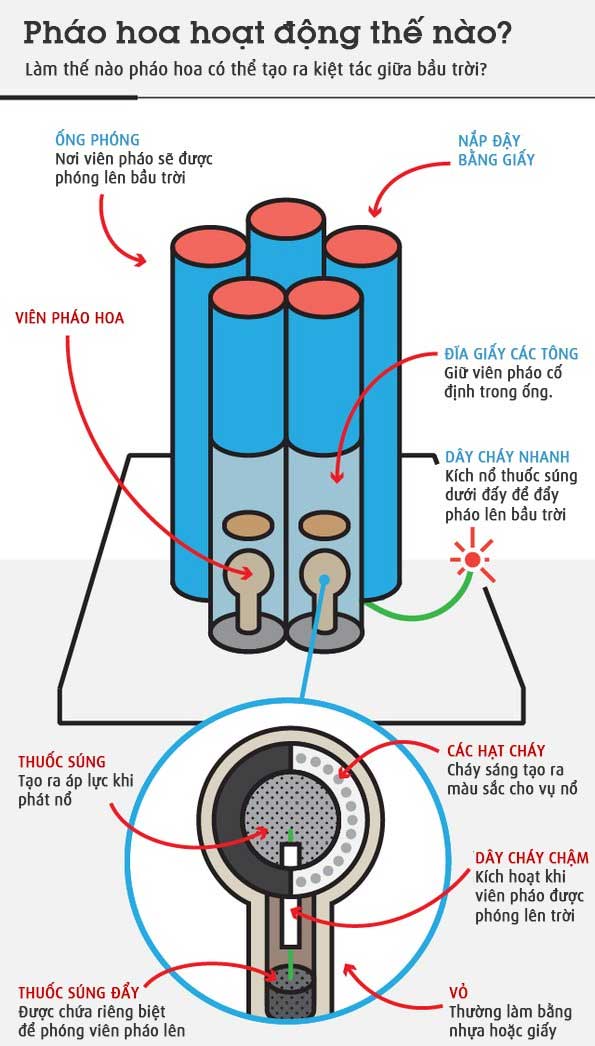How does fireworks work?
On major occasions around the world, fireworks are always performed in public places with spectacular scenery and colorful sounds.
So how does fireworks work? How can fireworks create vibrant colors in the night sky? Basically, only the cannon, gunpowder, ignition wire, burning particles and especially the accurate calculation will do it. How detailed? Please see below.
Fireworks are believed to have originated from the Han Dynasty, China thousands of years ago. It was then simply made by putting gunpowder into a bamboo tube and throwing it into a bonfire. (see more about Firework invention history). As for modern cannon, the bamboo tube has been replaced by a shell, which contains an explosive mixture and slow burning wire. But that's just the basic and still not enough, there are many other small but important components.
For modern fireworks technology, it is required to create explosions more and more gorgeous, sparkling and sparkling . In addition to the sound from the explosions, people increasingly want to emphasize the color factor, creating more beautiful and monumental shapes. And in the history of development, it was not until the Renaissance in Italy that people could create more colors for fireworks by adding steel and coal powder to create yellow and orange.
Gradually, fireworks artists experimented with adding other metals so that when they burn, they absorb the energy from the explosion and emit the colors. For example, adding strontium to make red, barium to green and copper to blue. These combinations and many other metals create the variety of colors you see in professional fireworks displays.
To fire fireworks into the sky, the fireworks craftsmen will create a chain of 2 explosions. First the cannon will be placed in the launcher (motar). The bottom of the cannon has a separate compartment containing gunpowder and people will quickly detonate the gunpowder package so that the cannon is launched into the sky without detonating the entire cannon. So what's inside the cannon?
Structure of cannon

Basically, a normal cannon consists of a casing, usually made of plastic or paper and this is the place containing everything inside. Inside the cannon are gunpowder and burning particles (Stars). These particles are arranged around each model depending on the shape of the explosion they want. Burning particles are coated with a metal layer to create color when burnt particles are burned. At the same time, the shape and size of the burnt particle will determine the effect and overall shape of the explosion in the sky (such as forming a star, circle, coconut tree, falling down, .)
Another part is a slow burning string running inside the firework. When launched, the propellant explosion also activates the slow ignition wire and it will slowly burn. The length of the slow fire wire will be accurately calculated so that the firework explodes at the desired height, sooner or later. For the more complex cannons, it also creates an explosive chain by connecting multiple fire wires to slow down to detonate the separate compartments in 1 cannon.
Fireworks technology is still developing. Currently, some fireworks designers have started using compressed air instead of conventional gunpowder to increase safety and create more accurately calculated explosions. On the other hand, people have also sought to make fireworks display more environmentally friendly by replacing many new materials. Currently, the chemicals for fireworks are heavy metals, which can be toxic and affect human health as well as the ecosystem below the surface.
Therefore, people still have much work to do to improve this art. So far, basically we are still using the cannons dating back to the 7th century but of course, it makes a much more beautiful explosion. Finally, let's see the fireworks display performed in the US recently.
- History of fireworks
- The birth history of fireworks
- Let's see the structure of each firework
- The incalculable harm of fireworks
- Decode 'secret' fireworks colors
- Making fireworks
- Why is the fireworks so gorgeous?
- Da Nang glows brightly in the fireworks night
- You probably did not know: Gunpowder was born during the making of elixir
- Farmers invented flood warning column with signal fireworks
- Video: Aircraft drone mounted fireworks release
- Revealing the first fireworks photo in the universe
- Marvel at the fireworks display created by the
 'Fine laughs' - Scary and painful torture in ancient times
'Fine laughs' - Scary and painful torture in ancient times The sequence of numbers 142857 of the Egyptian pyramids is known as the strangest number in the world - Why?
The sequence of numbers 142857 of the Egyptian pyramids is known as the strangest number in the world - Why? History of the iron
History of the iron What is alum?
What is alum?